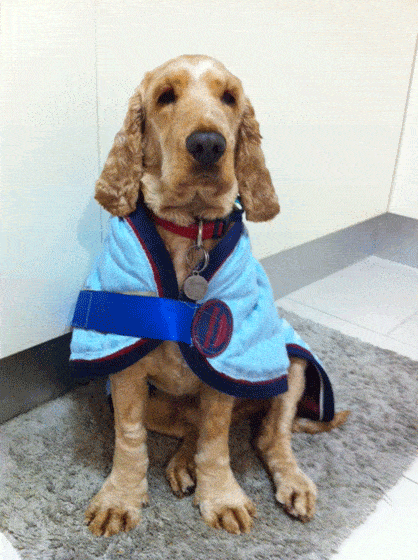Around 80% of older dogs suffer from canine arthritis, (aged 8 years or above), and approximately 20% of adult dogs*. As dog owners we all want to know how to help our dog with joint pain live a high quality, pain-free lifestyle.
The first step is to understand what you’re dog is dealing with and then find a way to ease the pain. This is what we’ll cover here:
By the way, we only suggest products that we believe benefit our community of dog owners. This article contains affiliate links. If you make a purchase after clicking on a link I may earn a small commission at no extra cost to you.
Why are dogs affected with arthritis?
Joint inflammation can occur for these reasons:
- a dog is overweight or obese
- because of an accident, and
- one of the most common causes is simply aging.
What is canine arthritis?
As with arthritis in humans, the natural breakdown of bones and cartilage in old age puts dogs at risk of developing arthritis. If you see an older dog in pain, especially showing signs of joint pain, the cause is likely to be arthritis.
The hip area is most likely to be affected, although dog owners frequently report symptoms of the condition showing up in the shoulders and elbows.
While there are no definite cures for arthritis in dogs, we don’t need to sit back and watch helplessly if our dog is in pain. In fact, there are home treatments to relieve pain in your dog to encourage easier joint movement – localized cooling.
Arthritic dog treatment using localised cooling
What is 'localised cooling' treatment?
It all comes down to controlling the intra-articular temperature. The intra-articular space is the area between the joints where cartilage tends to rub together, break down, and become damaged. The body’s natural response is to swell to protect the area from even more damage. This is how inflammation occurs and it becomes a painful cycle which gradually gets worse if it’s not treated.
Research shows that heat tends to encourage the breakdown of cartilage*, so it’s widely believed that cold temperatures could have the opposite effect.
Reducing the intra-articular temperature in dogs
If you’re wondering how to manage dog pain with localised cooling, it’s all about reducing the intra-articular temperature to minimise cartilage breakdown and ultimately limit the level of inflammation present in the joints. The temperature can be reduced in 2 ways:
- using localised, topical application of ice packs, or
- by running an ice bath for the dog.
You can use ice packs in the same way that you’d use a bag of frozen peas for a bumped head. That is by firmly placing the pack on to the affected area and securely holding it in place.
The coldness of the ice pack works to reduce the intra-articular temperature, showing average drops of 2.2 degrees celsius at 5 minutes*, 4.1 degrees at 15 minutes, and 6.5 degrees at 30 minutes. In studies, the effects of the temperature drop have been notable.
Dogs that were previously in pain have shown these changes:
- reduced inflammation
- easier movement, and
- an apparent reduction in discomfort
Ice baths can be a little more uncomfortable for dogs, but they can also be hugely beneficial for a dog in pain. Just 15 minutes in an ice bath shows intra-articular temperature drops of 20.2 degrees on average, which has been shown to be very effective at minimising pain and discomfort.
The benefits of ice baths and localized cooling typically last between 22 minutes and 1 hour as the dog begins to warm up and the joints return to their base temperature.
Experts trying to help an arthritic dog often recommend regular cooling temperatures to replicate the results frequently and improve the quality of life for dogs in pain.
If you’re able to get your dog to the beach and into the cold seawater or encourage him into a pool, he’ll really enjoy the benefits
Is localised cooling dangerous?
Although localised cooling is heavily focused on helping a dog with pain, some dog owners may be worried that this method of treatment is actually doing more harm than good. Cold temperatures can be very detrimental to canine health, and experts recommend that domestic pets, particularly those who aren’t accustomed to severely cold conditions, shouldn’t be exposed to temperatures below 7 degrees celsius* without wearing warming and protective winter clothing.
This begs the question of whether it’s safe and humane to apply ice packs or to run an ice bath, for dogs with arthritis.
Interestingly, it’s been found that localised cooling, and even ice baths to some extent, are not risky for dogs as long as they’re only exposed to the cold temperatures temporarily and allowed to warm back up to their normal base temperature afterwards. Although locally applied ice packs have a significant effect on the intra-articular temperature, causing it to drop dramatically and reduce inflammation, the core temperature, when taken rectally, remains remarkably stable. In fact, ice packs applied for up to 15 minutes typically have no effect on core temperature, and there’s an average drop of just 0.5 degrees celsius after a 30 minutes application.
As can be expected, ice baths tend to reduce core temperature a little more, but with an average drop of just 1.6 degrees, this is nothing a dog can’t handle, and certainly won’t cause a dog to be in pain.
Be very careful not to ‘burn’ the dog’s skin with cold packs.
6 ways to relieve dog's joint pain
- Regular exercise – Make sure he still has regular exercise with you. It might be a slower walk with you than the brisk walk or run when he was younger, but exercise is still important. It keeps the joints mobile, muscles working and helps keep the weight down.
- Creature comforts – Make sure he has a warm, comfortable dog bed that he can get in and out of easily. Get him up off the cold floor and out of a draft.
- Check his diet – supplement with omega oils and supplements
- Weight management – If your dog is overweight there will be more pressure on the joints which increases inflammation in the joints causing more pain and irritation.
- There are many experimental treatments, but as yet there appears to be nothing that’s proven to more beneficial for pain and inflammation than localised cooling.
- Visit your vet
The effects of arthritis can be devastating. I know how it hurts to watch your buddy suffer and struggle with everyday activities like walking or getting up after laying down and hearing those little creaks and sighs. That’s why it’s important to do what we can to ease their pain and help make life comfortable and give him the best quality of life.
For extra comfort for your dog, we suggest having a look at our cosy beds and blankets for your dog in the cold winter months.
If you’re wondering how to help a dog with arthritis, focus on getting that intra-articular temperature down – that’s the key.
You might also like
 How to Safely Exercise an Arthritic Dog
How to Safely Exercise an Arthritic Dog How to Stop Dogs Chewing their Bed / Destructive Chewing
How to Stop Dogs Chewing their Bed / Destructive Chewing Pooper Scooper with a Long Handle – All in One
Pooper Scooper with a Long Handle – All in One How to Get Your Dog to Sleep Later in the Morning
How to Get Your Dog to Sleep Later in the Morning Beds for Special Pooches
Beds for Special Pooches What Food is Best for my Dog?
What Food is Best for my Dog? Pooper Scooper to Hook on a Leash
Pooper Scooper to Hook on a Leash Best Compostable Dog Poop Bags
Best Compostable Dog Poop Bags Washable Dog Blankets
Washable Dog Blankets Mastering Puppy Sleep : Tips for a Restful Night
Mastering Puppy Sleep : Tips for a Restful Night



